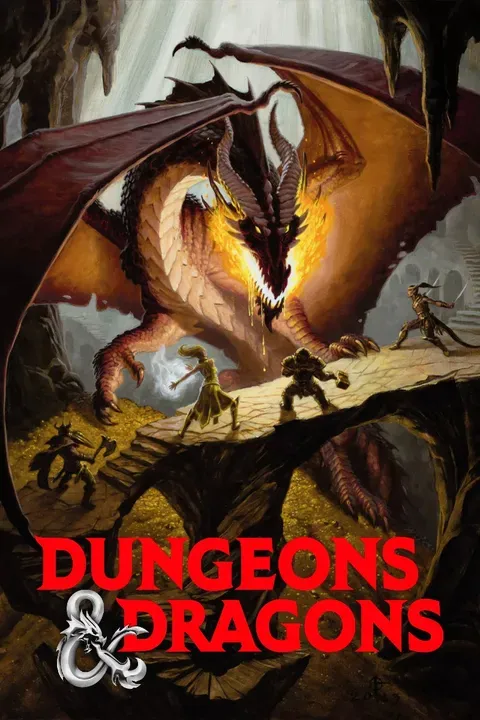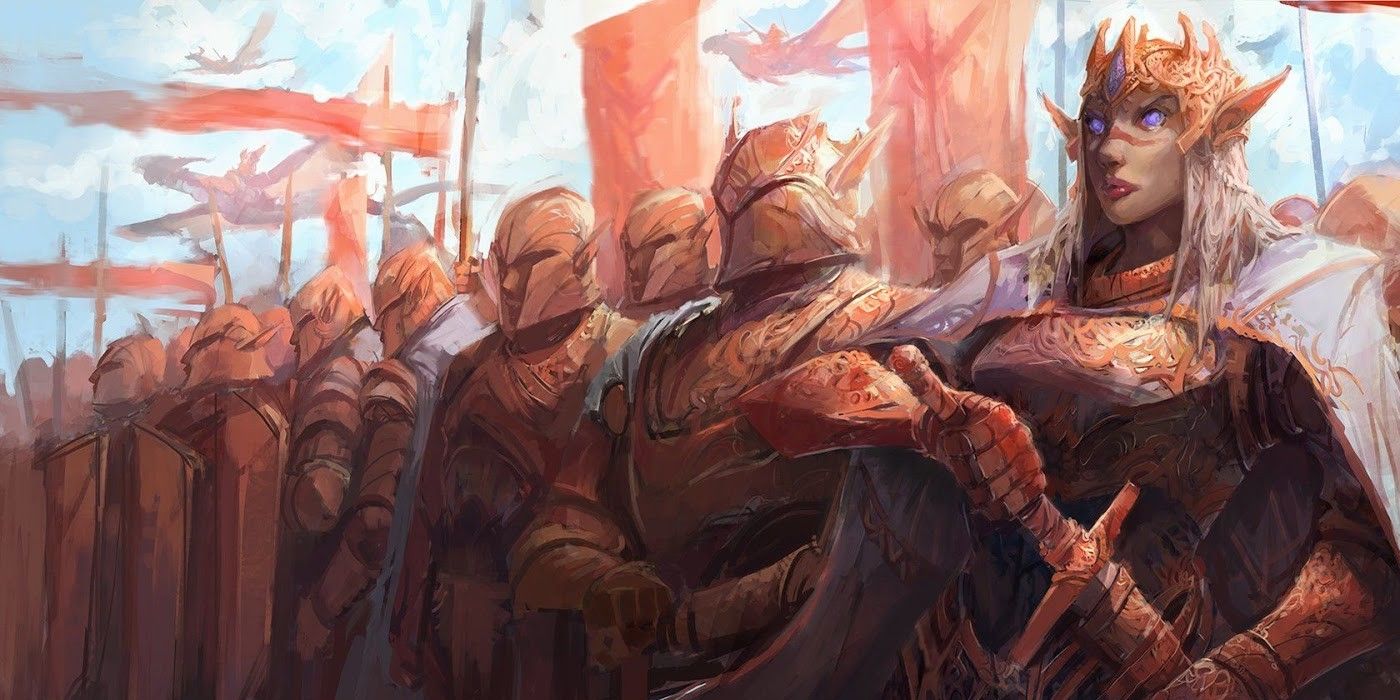Quick Links
Dungeons & Dragons excels at taking a simple ruleset and providing endless opportunity for imaginative gameplay, but some of its mechanics can be tricky. Figuring out how 5E's damage immunities, resistances, and vulnerabilities work goes from straightforward to complicated in a hurry, so some players may need help. Knowing the ins and outs of how these rules work can make the difference between an all-star player character saving the day and a grueling battle that players won't enjoy at all.
Everyone in a typical DnD campaign or even a one-shot mission must know how to handle damage resistances/immunities/vulnerabilities, on both sides of the DM screen. While avoiding meta-knowledge, players can find clever ways to deal with monster resistances/immunities, and the DM can juggle all these details to make combat easier, harder, or simply more original to take even the most seasoned DnD players by surprise. A good DM will tweak this game's countless knobs to make every adventure feel fresh, and that includes how damage is dealt -- or isn't.
Updated on February 23rd, 2024 by Louis Kemner: This feature about damage immunity, resistance, and vulnerabilities has been updated with more information for any D&D player or dungeon master to refer to during their games, as well as to adhere to CBR's most recent standards in formatting.

Dungeons & Dragons: What Are Reactions & How Do They Work?
Every Dungeons & Dragons character has access to reactions during combat, but not everyone takes advantage of them. Here's how they work.Vulnerability, Resistance, & Immunity Affect Combat Damage
At its base, it is easy enough to understand the three terms of D&D vulnerability, resistance, and immunity for monsters. Whenever damage is done in D&D 5e, it is damage of a certain type, such as fire, cold, or force. Each of the three terms modifies how much damage a creature takes from those specific damage types. Immunity means damage of that type is reduced to zero, resistance means it is halved and vulnerability means it is doubled, an intuitive system similar to found in other RPG titles or even games like the Pokémon series. "Resistance" could mean any reduction of damage in theory, but for simplicity's sake, D&D resistance halves the damage, and rounding up or down can be left to the dungeon master/DM's discretion.
However, as with any learning experience, things can get more complicated quickly once players start digging into the thick of the game. There are a few common questions that become immediately apparent once the division of "magical" and "nonmagical" damage comes into play. For instance, some creatures or spells come with resistance to both a damage type and, more broadly, "nonmagical" damage. Would such a creature take three-fourths the damage from a nonmagical attack of the damage type they have resistance to?
In short: No. Resistances, as with many other mechanics in D&D 5e, do not stack. Paying attention to magical and nonmagical damage types is important because it will allow players to circumvent certain immunities and resistances that may be giving them trouble. Beginners playing martial classes can struggle when fighting monsters that have immunity to nonmagical damage types, only to eventually realize that any magical source of damage is doing magical damage by default.
This means that even a +1 sword is not just doing slashing damage, but magical slashing damage that would bypass many creatures' resistance. The same goes for enchanted weapons, weapons produced by spells, and any damage type produced by spells at all. If players truly don't have any magical means of doing damage, then understanding the importance of doing so can help them prioritize finding such a means during their quest.

Every Skill Proficiency In D&D 5e, Ranked by Usefulness
It's easy for new D&D 5e players to be overwhelmed by the sheer number of skill proficiencies, but some stand out as more useful skills than others.Using Vulnerability, Resistance & Immunity During a Quest
Critical Role's Way of the Cobalt Soul Monk build utilizes a feature called Extract Aspects, which allows the player character to pull information about an enemy's immunities, resistances and vulnerabilities, which can completely turn the tide of battle.
Seasoned D&D players are capable of using meta-knowledge to immediately circumvent a monster's damage resistances/immunities or exploit its damage vulnerabilities. However, that is unsporting, so veteran players can use the same tactics as novice players and have their characters figure all this out as they go. DnD damage immunities may lead to player characters making wasted attacks or worse, wasted spells that eat up spell slots, but any in-game mercenary or hero would know the value of trial and error while fighting a breathtaking variety of monsters and enemy soldiers/wizards. Ideally, the campaign will have some restraint with monster diversity, such as focusing mostly on the undead in Curse of Strahd or cold-based monsters in Icewind Dale: Rime of the Frostmaiden, so players may face the same monster types and soon learn that most undead shrug off poison and ice-based monsters are immune to cold. It's trial and error, but not to a frustrating extent, a happy medium.
The sorcerer class is one of the best classes to deal with monsters' immunities, resistances, and vulnerabilities to damage thanks to their meta magic. Assuming the sorcerer rations their sorcery points during a classic dungeon crawl or exhausting boss fight, that spellcaster can freely spend sorcery points to change their best spells into anything a monster isn't resistant or immune to, and some options are remarkably consistent with this. Plenty of foes laugh in the face of fire and cold damage, but relatively few are resistant to force damage or acid damage, so a wily sorcerer can keep choosing those safe options during a campaign. Even other spellcasters, such as the wizard class, can use the Metamagic feat to get a few sorcery points and change their spells' elements to bypass monster immunities. Such spellcasters must do even more rationing than sorcerers, but in critical fights where the party's options are limited, might be the only way to finish a monster off.

Dungeons & Dragons: How Bonus Actions Work
In Dungeons & Dragons, bonus actions provide extra opportunities to cast spells, make attacks or disengage from a sticky situation.Using Immunities, Resistances & Vulnerabilities In A Campaign
A dungeon master can simply use a monster's existing stat block in a campaign to determine its damage resistances, vulnerabilities, and immunities, but clever DMs know how to adjust anything and everything on the fly, such as for monsters. One reason is to keep veteran players on their toes, challenging them with monsters that feature unexpected damage resistances/immunities as well as newer attack types. For example, a squad of kobolds may have been enchanted to become immune to fire and lightning since they serve an evil wizard who specializes in those elements, and they have visual cues to match, such as flaming eyes or lightning crackling on their scaly skin. Any player would pick up on that hint and save their Fireball spells for another battle instead. That's a fine way to flavor the minions of a boss monster.
The DM might also grant monsters new or different damage immunities or resistances if the party is getting too comfortable with the same few damage types or spells and things are getting repetitive. Even if "always cast Fireball" is a meme, some players might take it seriously, or they'll just cast Cone of Cold or Lightning Bolt on repeat as their favorite offensive spells. Here and there, the DM can challenge the player to shake things up with damage resistances/immunities, which gives sorcerers something to do with their sorcery points and Metamagic besides quicken or twinspell.
The DM must make sure they don't totally stymie the party with unexpected monster immunities, though. They can provide hints, such as a sequence in an icy mountain range where cold-resistant monsters feel intuitive, such as ice devils, bheur hags, and white dragons. The DM might also sprinkle in some bonus weapons, spell scrolls, or potions to give the players temporary options for new and relevant damage types.

How The Rogue's Sneak Attack Works In D&D 5e, Explained
The Sneak Attack is the bread and butter of a Dungeons & Dragons 5e Rogue, but it can be difficult for new players to grasp all the feature's details.Notable Resistances, Immunities, and Vulnerabilities For Player Characters in D&D
Player characters benefit from all kinds of traits and features based on their biological race, from a half-orc's Relentless Endurance to a changeling's ability to shapeshift at will, which lends itself to strong roleplay. Plenty of character races also get resistance to all kinds of damage types and effects, granting them situational but totally free defenses during their adventures. In fact, some damage/condition resistances are so broadly useful, a player might select a certain D&D race just because of that resistance, with fire resistance and necrotic resistance being two standouts. Still, players are urged to treat these damage/condition resistances as the bonus perks they are, and not attempt to build an entire character around resistance. After all, player characters can find the right magical items to grant themselves resistance to a relevant damage type during a mission or campaign, such as rings of elemental resistance, albeit at the cost of an attunement slot.
Fire resistance is a real standout, since fire damage is common among enemy monsters, from red dragon boss battles to wizards who cast the likes of Fireball and Scorching Ray, or even enemy warlocks who use fire-based abilities like Hellfire. Conversely, players may run into many enemies resistant to or immune to fire, from the aforementioned red dragons to fire giants and efreeti, so players can see how impactful the fire element can be. So, players who expect lots of fire-based enemies may end up building a tiefling or fire genasi character, especially if they were already going to build something charisma-based, such as a warlock or sorcerer.
Poison damage is rarely a safe bet for player characters, but conversely, a stunning variety of enemies will deal poison damage and/or inflict the poisoned condition, either with magic or attacks such as fang bites or claw swipes. So, a player can choose a poison-resistant race if they expect to face such foes often, with dwarves, duergars, and yuan-ti being strong picks. It helps that the dwarf race is already an appealing one thanks to strong traits such as generous ability score increases, darkvision, and tool proficiency, among others.
If a player wishes to shrug off enemy spellcasting without relying on spells like Counterspell and Dispel Magic, then the deep gnome race is a fine option. Deep gnomes have resistance to any magical effect that makes them perform an Intelligence, Wisdom, or Charisma saving throw, and as veteran players know, a huge variety of spells force those three types of saving throw, from Hold Person to Command and Banishment, to name three prominent examples. Even if the deep gnome character's class doesn't give them proficiency against any of those three abilities, having advantage on the rolls is an excellent line of defense.

Dungeons and Dragons
A fantasy roleplaying tabletop game designed for adventure-seekers, the original incarnation of Dungeons & Dragons was created by Gary Gygax in 1974.
- Franchise
- Dungeons & Dragons
- Original Release Date
- January 26, 1974
- Publisher
- Wizards of the Coast , TSR Inc.
- Designer
- E. Gary Gygax , Dave Arneson
- Player Count
- 4-8 Players Recommended
- Age Recommendation
- 12+
- Length per Game
- 3 hours +
- Expansions
- Dungeons & Dragons 2nd Edition , Dungeons & Dragons 3rd Edition , Dungeons & Dragons 4th Edition , Dungeons & Dragons 5th Edition



